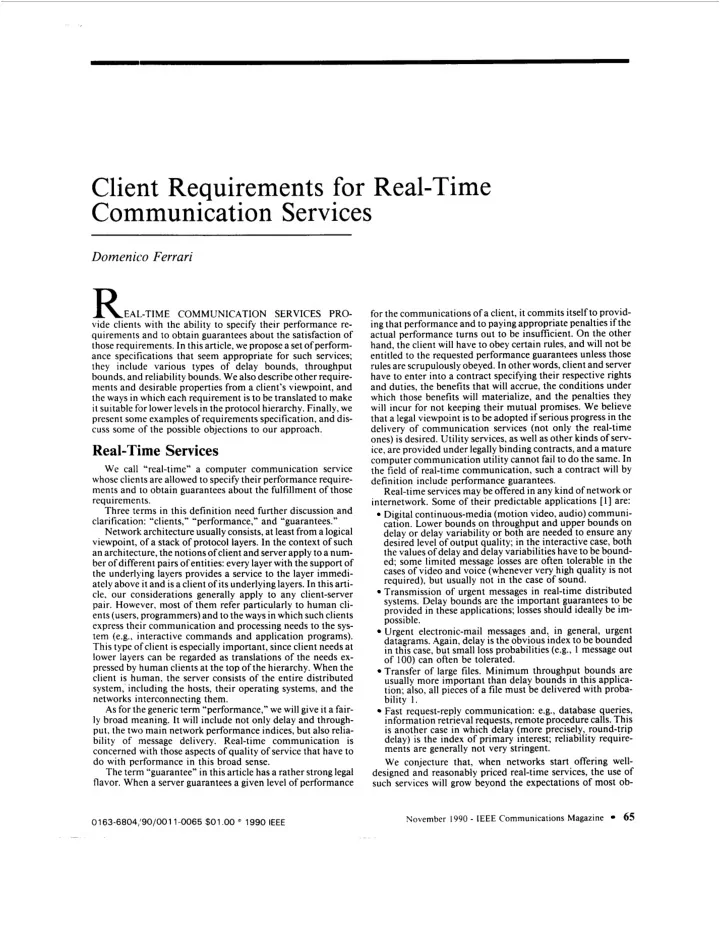

Communication Services zyxwvutsrqponmlkjihgfedcbaZYXWVUTSRQPONMLKJIHGFEDCBA Client Requirements for Real-Time Domenico Ferrari R EAL-TIME COMMUNICATION SERVICES PRO- for the communications of a client, it commits itself to provid- vide clients with the ability to specify their performance re- ing that performance and to paying appropriate penalties if the cuss some of the possible objections to our approach. zyxwvutsrqponmlkjihgfedcbaZYXWVUTSRQPONMLKJIHGFEDCBA quirements and to obtain guarantees about the satisfaction of actual performance turns out to be insufficient. On the other those requirements. In this article, we propose a set ofperform- hand, the client will have to obey certain rules, and will not be ance specifications that seem appropriate for such services; entitled to the requested performance guarantees unless those they include various types of delay bounds, throughput rules are scrupulously obeyed. In other words, client and server bounds, and reliability bounds. We also describe other require- have to enter into a contract specifying their respective rights ments and desirable properties from a client’s viewpoint, and and duties, the benefits that will accrue, the conditions under the ways in which each requirement is to be translated to make which those benefits will materialize, and the penalties they internetwork. Some of their predictable applications zyxwvutsrqponmlkjihgfedcbaZYXWVUTSRQPONMLKJIHGFEDCBA [ zyxwvutsrqponmlkjihgfedcbaZYXWVUTSRQPONMLKJIHGFEDCBA it suitable for lower levels in the protocol hierarchy. Finally, we will incur for not keeping their mutual promises. We believe present some examples of requirements specification, and dis- that a legal viewpoint is to be adopted if serious progress in the delivery of communication services (not only the real-time ones) is desired. Utility services, as well as other kinds of serv- Real-Time Services ice, are provided under legally binding contracts, and a mature computer communication utility cannot fail to do the same. In We call “real-time” a computer communication service the field of real-time communication, such a contract will by whose clients are allowed to specify their performance require- definition include performance guarantees. ments and to obtain guarantees about the fulfillment of those Real-time services may be offered in any kind of network or 11 are: requirements. Three terms in this definition need further discussion and Digital continuous-media (motion video, audio) communi- clarification: “clients,” “performance,” and “guarantees.” cation. Lower bounds on throughput and upper bounds on Network architecture usually consists, at least from a logical delay or delay variability or both are needed to ensure any viewpoint, of a stack of protocol layers. In the context of such desired level of output quality; in the interactive case, both an architecture, the notions of client and server apply to a num- the values of delay and delay variabilities have to be bound- ber of different pairs of entities: every layer with the support of ed; some limited message losses are often tolerable in the cases of video and voice (whenever very high quality is not the underlying layers provides a service to the layer immedi- required), but usually not in the case of sound. ately above it and is a client of its underlying layers. In this arti- Transmission of urgent messages in real-time distributed cle, our considerations generally apply to any client-server systems. Delay bounds are the important guarantees to be pair. However, most of them refer particularly to human cli- provided in these applications; losses should ideally be im- ents (users, programmers) and to the ways in which such clients possible. express their communication and processing needs to the sys- Urgent electronic-mail messages and, in general, urgent tem (e.g., interactive commands and application programs). datagrams. Again, delay is the obvious index to be bounded This type of client is especially important, since client needs at in this case, but small loss probabilities (e.g., 1 message out lower layers can be regarded as translations of the needs ex- of 100) can often be tolerated. pressed by human clients at the top of the hierarchy. When the Transfer of large files. Minimum throughput bounds are client is human, the server consists of the entire distributed usually more important than delay bounds in this applica- system,- including the hosts, their operating systems, and the tion; also, all pieces of a file must be delivered with proba- networks interconnecting them. bility I . As for the generic term “performance,” we will give it a fair- Fast request-reply communication: e.g., database queries, ly broad meaning. It will include not only delay and through- information retrieval requests, remote procedure calls. This put, the two main network performance indices, but also relia- is another case in which delay (more precisely, round-trip bility of message delivery. Real-time communication is delay) is the index of primary interest; reliability require- ments are generally not very stringent. concerned with those aspects of quality of service that have to do with performance in this broad sense. We conjecture that, when networks start offering well- The term “guarantee” in this article has a rather strong legal designed and reasonably priced real-time services, the use of flavor. When a server guarantees a given level of performance such services will grow beyond the expectations of most ob- November I990 - IEEE Communications Magazine 65 0163-6804,‘90/0011-0065 $01 .OO 1990 IEEE
Recommend
More recommend